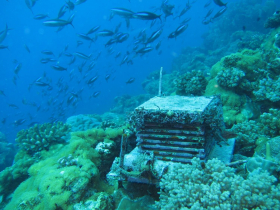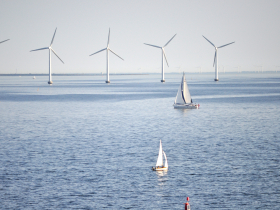ECOFUNC - Functional ecology of coastal trophic and social-ecological networks
The team EcoFunc’s objectives are to establish a link between individuals’ functions (growth, reproduction, bleaching, toxicity, metabolism, diet, migration, etc), ecosystem’s functioning (functional diversity, food webs, resilience) and social-ecological network’s functioning (nature’s contribution to peoples, cultural benefit, risk, perception by actors of the seashore). The originality of the team is to be based on a multi-scale approach (traits, diversity, trophic functioning, social-ecological functioning), a strong numerical basis (data analysis and modelling) and a strong interdisciplinarity (collaborations with human and math/computer sciences). Understanding the effects of the ecosystem functioning on the reaction to climate change and global change more generally, will allow a better understanding of resilience’s factors, the definition of functional ecosystem health indicators and a social-ecological approach to scenarios of possible evolution.
Axe 1/ Traits and functional diversity : from experiments to chronological series from the field
Determinism of microphytoplankton and in particular toxic diatoms (species and functional diversity)
Biological and physiological traits of toxic algaes and tropical corals, under environmental influences. Sensitivity of temperatures anomalies.
Interactions between trophic diatoms and zooplankton, chemical communication
Axe 2/ Trophic ecology and trophic network functioning
Isotopic tracers and stomach contents, role of cephalopods in food webs, validation of trophic models by consumers’ trophic levels determined through isotopes
Functional diversity of coral reed associated communities and associated resilience.
Cumulative impacts, effects on the food-web functioning, and ecosystem health associated (marine energy, climate change, fisheries)
Axe 3/ From functional ecology to the characterization of the perception by humans of risks and benefits associated to the functioning of social-ecological networks.
Risks associates to coral bleaching and toxic algae blooms
Ecosystem services associated to Cephalopods
Ecosystem perception and interactions with networks of actors, in the case of the development of wind farms
Latest scientific articles
2024
-
. 2024. “Tracing The Fate Of Seabird‐Derived Nitrogen In A Coral Reef Using Nitrate And Coral Skeleton Nitrogen Isotopes”. Limnology And Oceanography. doi:10.1002/lno.12485. https://aslopubs.onlinelibrary.wiley.com/doi/10.1002/lno.12485.
-
. 2024. “Settlement Patterns And Temporal Successions Of Coral Reef Cryptic Communities Affect Diversity Assessments Using Autonomous Reef Monitoring Structures (Arms)”. Scientific Reports 14 (1). doi:10.1038/s41598-024-76834-8. https://www.nature.com/articles/s41598-024-76834-8https://www.nature.com/articles/s41598-024-76834-8.pdfhttps://www.nature.com/articles/s41598-024-76834-8.pdfhttps://www.nature.com/articles/s41598-024-76834-8.
-
. 2024. “Intraspecific Genetic Lineages Of A Marine Mussel Show Behavioural Divergence When Exposed To Microplastic Leachates”. Environmental Pollution 340 (1). doi:https://doi.org/10.1016/j.envpol.2023.122779.
-
. 2024. “Testing For Concordance Between Predicted Species Richness, Past Prioritization, And Marine Protected Area Designations In The Western Indian Ocean”. Conservation Biology. doi:10.1111/cobi.14256. https://conbio.onlinelibrary.wiley.com/doi/10.1111/cobi.14256.
-
. 2024. “Complex Multivariate Model Predictions For Coral Diversity With Climatic Change”. Ecosphere 15 (12). doi:10.1002/ecs2.v15.1210.1002/ecs2.70057.
2023
-
. 2023. “An Integrated Conceptual Model To Characterize The Effects Of Offshore Wind Farms On Ecosystem Services”. Ecosystem Services 60: 101513. doi:10.1016/j.ecoser.2023.101513. https://linkinghub.elsevier.com/retrieve/pii/S2212041623000050.
-
. 2023. “New Insights Into The Diversity Of Cryptobenthic Cirripectes Blennies In The Mascarene Archipelago Sampled Using Autonomous Reef Monitoring Structures (Arms)”. Ecology And Evolution 13 (3). doi:10.1002/ece3.v13.310.1002/ece3.9850. https://onlinelibrary.wiley.com/toc/20457758/13/3.
-
. 2023. “The Effect Of Interspecific And Intraspecific Diversity On Microplastic Ingestion In Two Co-Occurring Mussel Species In South Africa”. Marine Pollution Bulletin 196 (115649). doi:https://doi.org/10.1016/j.marpolbul.2023.115649.
-
. 2023. “Euendolithic Infestation Of Mussel Shells Indirectly Improves The Thermal Buffering Offered By Mussel Beds To Associated Molluscs, But One Size Does Not Fit All”. Diversity 15 (2: 239). doi:https://doi.org/10.3390/d15020239.
-
. 2023. “Socio-Political Acceptability Of Floating Offshore Wind Farms In France: Challenges And Perspectives For Marine Governance Towards Sustainability”. Ocean & Coastal Management 236: 106513. doi:10.1016/j.ocecoaman.2023.106513. https://linkinghub.elsevier.com/retrieve/pii/S0964569123000388.
Team members
PhD Thesis
Programs
| 2020 to 2024 | PHENOMEN |
| 2022 to 2024 | coolOYSTER |
| 2024 | CRYPTOREEF2 |
| 2020 to 2023 | SENSITROPH |
| 2023 | PAGAILLE |
| 2019 to 2022 | INCIDENCE |
| 2018 to 2021 | ECUME |
| 2017 to 2020 | CephsandChefs |
| 2020 | Impact écosystémique des efflorescences d'espèces toxiques en lien avec les changements environnementaux et climatiques : détection de ruptures dans des séries temporelles multivariées |
| 2020 | EUBIOTTKK |
| 2016 to 2018 | ANR TROPHIK |
| 2015 to 2017 | The EcApRHA project |
| 2013 to 2017 | ANTHROPOSEINE |
| 2013 to 2017 | ANR Gigassat |
| 2012 to 2016 | DEVOTES |
| 2013 to 2015 | FLAM |
| 2013 to 2015 | Pêcheries de Céphalopodes : outils pour gérer la ressource, préserver le recrutement et valoriser la production |
| 2011 to 2014 | ANR COMANCHE |
| 2013 to 2014 | PEGASEAS |





